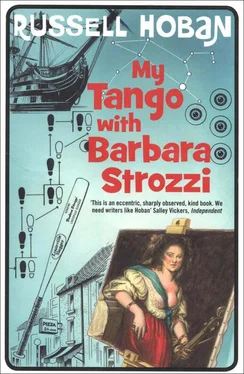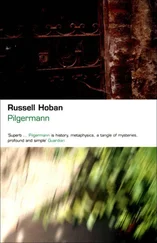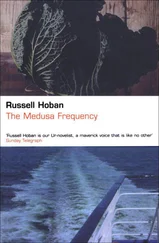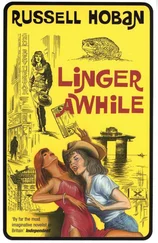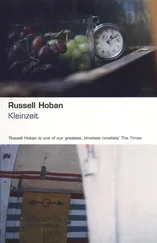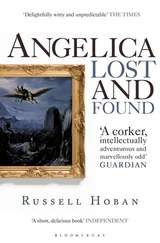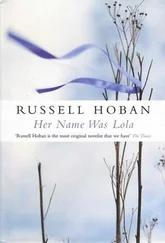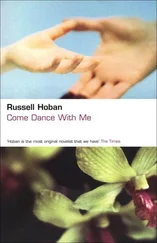Russell Hoban - My Tango With Barbara Strozzi
Здесь есть возможность читать онлайн «Russell Hoban - My Tango With Barbara Strozzi» весь текст электронной книги совершенно бесплатно (целиком полную версию без сокращений). В некоторых случаях можно слушать аудио, скачать через торрент в формате fb2 и присутствует краткое содержание. Год выпуска: 2007, Издательство: Bloomsbury UK, Жанр: Современная проза, на английском языке. Описание произведения, (предисловие) а так же отзывы посетителей доступны на портале библиотеки ЛибКат.
- Название:My Tango With Barbara Strozzi
- Автор:
- Издательство:Bloomsbury UK
- Жанр:
- Год:2007
- ISBN:нет данных
- Рейтинг книги:5 / 5. Голосов: 1
-
Избранное:Добавить в избранное
- Отзывы:
-
Ваша оценка:
- 100
- 1
- 2
- 3
- 4
- 5
My Tango With Barbara Strozzi: краткое содержание, описание и аннотация
Предлагаем к чтению аннотацию, описание, краткое содержание или предисловие (зависит от того, что написал сам автор книги «My Tango With Barbara Strozzi»). Если вы не нашли необходимую информацию о книге — напишите в комментариях, мы постараемся отыскать её.
My Tango With Barbara Strozzi — читать онлайн бесплатно полную книгу (весь текст) целиком
Ниже представлен текст книги, разбитый по страницам. Система сохранения места последней прочитанной страницы, позволяет с удобством читать онлайн бесплатно книгу «My Tango With Barbara Strozzi», без необходимости каждый раз заново искать на чём Вы остановились. Поставьте закладку, и сможете в любой момент перейти на страницу, на которой закончили чтение.
Интервал:
Закладка:
I needed to walk the decks of HMS Victory . I needed to touch with my hands those great guns; I needed to stand in the orlop deck at the place where Nelson died. A visit to Portsmouth was what I needed. HMS Victory might seem a long way from the crypt at St James’s Clerkenwell, even farther away from seventeenth-century Venice and Barbara Strozzi but, seen from Mercury and Venus as they look down on us, nothing is far away from anything.
On a dull and sultry day in July I went to Waterloo and took a South West train to Portsmouth Harbour. I seem to run into that kind of day when I’m looking for some hard-to-find thing, like a left-handed monkey wrench or whatever. After being nowhere for a while the train found Guildford. Then gradually the views on both sides became fields and trees and the sky seemed to widen. Time moved slowly and was further slowed down by the many mothers who were patiently reading to their children, playing games with them and feeding them snacks. The buffet car sent its nice little earner through the carriages with many kinds of overpriced refreshment but I’d brought my sandwich and bottle of water with me and was able to resist when the trolley paused for me.
Haslemere and other stations unrolled before and behind in due course while I read a book about Bellerophon , the seventy-four-gun ship of the line in Nelson’s fleet known as Billy Ruffian to the sailors. Designed by Thomas Slade who also laid down the lines for HMS Victory , she was built in 1782 in the yard of Edward Greaves at Frindsbury in the River Medway in Kent. I’d received this book from a friend, and having nothing on HMS Victory I made do with the smaller vessel. More than three thousand oak trees were cut down to make the frames, strakes, beams, carlings, masts, yards and spars that with axe, saw, adze and drawknife were shaped and assembled into Billy Ruffian .
After my lunch I dozed off for a while and awoke when the train pulled into Petersfield. The sky was heavying up in a brooding sort of way and I had no doubt that its intentions were serious. Time now speeded up a little and Portsmouth Harbour was achieved, flaunting a vertical blot on the seascape that was clearly commissioned by one of those committees that can’t leave anything alone. I learned later that it’s called the Spinnaker Tower.
When I came out of the station I expected to see or at least hear gulls wheeling over the harbour but there were none. It was a half-mile or so from the railway station to HMS Victory , past HMS Warrior , various naval buildings, small craft moored in the harbour and a succession of eateries, boat-ride docks and other tourist attractions barnacled on to the dockyard along with a pub whose name I don’t remember, the Royal Naval Museum and a shop that sold HMS Victory books, videos, and every kind of souvenir that England could expect. It was raining by then as it usually does when I’m looking for a left-handed monkey wrench or heroic inspiration.
Having bought my ticket I walked on glistening cobbles, along with the world and his camera, wife and children, towards the masts and rigging of Nelson’s flagship which became gradually larger in our eyes as we approached. A life-size effigy of Nelson, a flat thing made of painted sheet metal, encouraged us to continue yet another half-mile or so to the queue waiting at the entrance to the ship.
HMS Victory is a three-decker 104-gun warship and it’s huge. I’d never seen anything so big made out of wood by human hands. No power tools, just tools made by hand and worked by hand. When my ticket was punched I was given a printed guide. I have an ingrained resistance to manuals and guides, so I just followed the crowd up the gangway and into the lower gun deck. I have a problem with seeing things: when I go to an exhibition of paintings I clock the pictures briefly but I don’t really study them, don’t properly get into them until I look at the reproductions in the catalogue at home and recall to life the images recorded by my mind. So now in HMS Victory’s lower gun deck I trudged by dim lanterns past the thirty-two-pounder guns and their tackle, the rammers, sponges and the hammocks slung above them, all of our many tourist feet treading the planks where men long dead had walked and run and fallen. I couldn’t see anything or feel anything, there was no privacy in which to see and feel.
Up and down steep stairs and companionways we went and at some point stood numerously in the orlop deck in front of the place where Nelson died. There was the oaken knee against which he leant as he lay dying. By it stood the painting of that scene by A. W. Devis. To the right was a painted wreath around the words, ‘HERE NELSON DIED’. The lighting was too bright, it magnified the absence that prevailed. Foolishly I had hoped to feel Nelson’s heroic death at the moment of victory but I felt only my own emptiness. You can buy a ticket to walk up and down and all around HMS Victory but the moment of Nelson’s death is not for sale.
Still we kept trudging, and after a while the world and his camera, wife, children and I stood on the quarter deck. ‘This is where Nelson was shot,’ said an American voice, ‘by a marksman in the rigging of the Redoubtable .’
‘ Le Redou table,’ I said.’Mizzen top.’ No one seemed to hear me. ‘HERE NELSON FELL, 21st Oct 1805,’ said the brass plaque.
On the way out I passed the great cabin and the stern lights through which Nelson must often have looked at the wake of his passage in all weathers. Now they showed today’s grey rainlight that gleamed on his table, his telescope and sextant.
Then I was out in the rain again. At the shop I bought a book on HMS Victory and a video tour of the ship. I walked back to the station and in a short time was on a train back to London. I closed my eyes and waited for delayed heroic inspiration. What came to me, dark and shadowy, were the frames and timbers I had seen in the hold. These were of oak, their forms heroically achieved by the concerted skills of men with axes, saws, adzes, drawknives and augers who shaped them into the structure that would be planked up as the flagship of the fleet. The beautiful drawings in the book showed the lines, the framing, planking, masting, yards and spars of the ship they had built. Englishmen now alive had in their genes the army of skills that had flourished in this English nation.
Two hundred years ago my people, the Jews, had no nation. Their skills were scattered throughout the diaspora. In Biblical times there were Jews who built ships and sailed them: Hiram shipped ivory, apes and peacocks to Solomon from Ophir. There were Jews on the sea and by the sea, working in Akko, Joppa and other ports. Jesus’s disciples were mainly Jewish fishermen who got their living in boats. But in my genes there was no army of Jews with axes, saws, adzes, drawknives and augers two hundred years ago.
I sat there in a funk for a certain time, then there came to mind Martin Buber’s books on the Hasidim. Aha! I said, and smote my forehead (one or two people looked at me): there are ships and ships; there is a great unsinkable oak-ribbed copper-bottomed ship of the mind, strong to weather any storm and impervious to all broadsides. Who built this ship? The zaddikim! Theirs the axes, the adzes, the augers, the strength of arm for the great unsinkable ship of the mind.
Who were these men? Rabbi Israel Ben Eliezer, the Baal Shem Tov! Dov Baer of Mezritch, the Great Maggid! Pinhas of Koretz and his school, yes! Such as these and other illustrious zaddikim were the men. Swarming up the rigging, they manned the yards and stood ready. With them behind me and the Louisville Slugger ready to hand I felt that I could deal with whatever had to be dealt with.
Читать дальшеИнтервал:
Закладка:
Похожие книги на «My Tango With Barbara Strozzi»
Представляем Вашему вниманию похожие книги на «My Tango With Barbara Strozzi» списком для выбора. Мы отобрали схожую по названию и смыслу литературу в надежде предоставить читателям больше вариантов отыскать новые, интересные, ещё непрочитанные произведения.
Обсуждение, отзывы о книге «My Tango With Barbara Strozzi» и просто собственные мнения читателей. Оставьте ваши комментарии, напишите, что Вы думаете о произведении, его смысле или главных героях. Укажите что конкретно понравилось, а что нет, и почему Вы так считаете.
